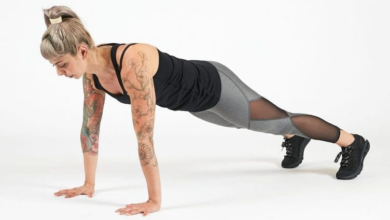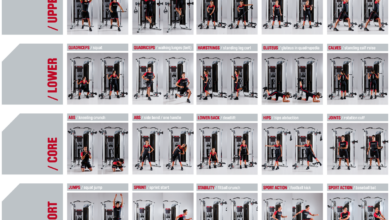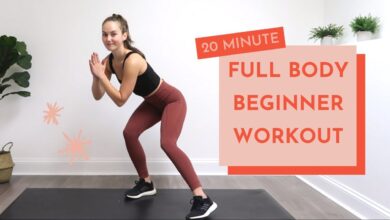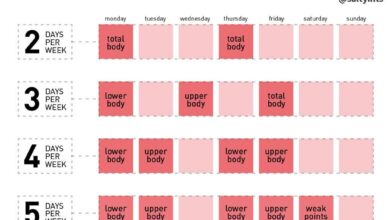
How Often Should You Switch Up Your Workouts?
How often should you switch up your workouts? It’s a question that plagues many fitness enthusiasts, and for good reason. We all crave that feeling of progress, but sometimes sticking to the same routine can lead to plateaus, boredom, and even injuries.
So, how do you find the sweet spot between consistency and variety?
The answer lies in understanding the benefits of switching things up. Variety can help you challenge your muscles in new ways, prevent boredom, and keep your body guessing, leading to better results. But, there’s a fine line between productive variety and overdoing it.
We’ll explore how often to switch up your workouts, how to do it effectively, and how to incorporate rest and recovery for optimal fitness gains.
Benefits of Workout Variety
Switching up your workouts is not just about keeping things interesting; it’s a crucial strategy for achieving optimal fitness results. Workout variety is like adding spice to your fitness journey, ensuring continuous progress and a fulfilling experience.
Impact on Muscle Growth and Development
Variety in your workout routine stimulates muscle growth and development in a more comprehensive way. By exposing your muscles to different exercises and movement patterns, you challenge them in new ways, forcing them to adapt and grow stronger.
“Variety in exercise is essential for optimal muscle growth and development.”
- Targeting Different Muscle Groups:When you consistently perform the same exercises, you primarily engage the same muscle groups. Introducing new exercises targets different muscle groups, leading to more balanced and overall muscle development.
- Varying Exercise Intensity and Duration:By alternating between high-intensity workouts and lower-intensity sessions, you create a more diverse training stimulus, promoting muscle hypertrophy (growth) and endurance.
- Promoting Muscle Adaptation:When you perform the same exercises repeatedly, your body becomes accustomed to the movement patterns, leading to plateaus in strength and muscle growth. By switching things up, you challenge your muscles in new ways, forcing them to adapt and become stronger.
Preventing Plateaus and Boredom
One of the most significant benefits of workout variety is its ability to prevent plateaus and boredom. When you consistently perform the same exercises, your body adapts to the routine, leading to a decrease in results.
“Variety in exercise can help to prevent plateaus and boredom, keeping your workouts engaging and effective.”
Switching up your workouts is crucial for preventing plateaus and keeping things interesting, but how often is too often? Some experts suggest changing things up every 4-6 weeks, while others advocate for a more gradual approach. It really comes down to your individual goals and how your body responds.
And just like the frequency of workout changes, the question of whether or not to supplement is also a topic of much debate, with experts debating the pros and cons. Ultimately, the key is to listen to your body and find what works best for you.
- Maintaining Motivation:Sticking to the same workout routine can become monotonous, leading to decreased motivation and a higher likelihood of quitting. Introducing new exercises and activities keeps things fresh and exciting, making it easier to stay motivated and consistent.
- Challenging Your Body:When your body becomes accustomed to a particular exercise, it stops making significant progress. By switching up your workouts, you continually challenge your body in new ways, promoting ongoing improvement.
- Avoiding Injuries:Performing the same exercises repeatedly can lead to overuse injuries. By incorporating different types of workouts, you distribute the stress on your body more evenly, reducing the risk of injuries.
Examples of Different Workout Types
There are numerous ways to add variety to your workout routine. Consider incorporating different types of exercises, such as:
- Strength Training:Focuses on building muscle mass and strength. Examples include weightlifting, bodyweight exercises, and resistance band training.
- Cardiovascular Training:Improves heart health and endurance. Examples include running, swimming, cycling, and dancing.
- Flexibility Training:Enhances range of motion and reduces the risk of injuries. Examples include yoga, Pilates, and stretching.
- High-Intensity Interval Training (HIIT):Combines short bursts of intense exercise with brief recovery periods. HIIT is an effective way to burn calories and improve cardiovascular fitness.
- CrossFit:A high-intensity workout program that combines elements of strength training, gymnastics, and metabolic conditioning.
Frequency of Switching Workouts
The frequency with which you switch up your workout routine can significantly impact your fitness journey. While consistent training is essential, introducing variety can help you avoid plateaus, reduce the risk of injuries, and keep your workouts engaging.
Switching up your workouts is crucial for keeping things interesting and preventing plateaus. Just like you might need a change of pace in your routine, you can also spice up your breakfast with a little creativity! Check out this awesome article on 5 ways to turn last night’s leftovers into a morning breakfast – it’s a great way to avoid food waste and add some variety to your meals.
Just like your workouts, your diet needs a little variety to keep things exciting!
Workout Frequency Recommendations
The ideal frequency for switching workouts depends on your fitness goals and level. Here’s a general guide:
- Beginners:Switching every 2-3 weeks is a good starting point. This allows your body to adapt to new movements and prevents overuse injuries.
- Intermediate:You can switch workouts weekly or every other week, introducing more challenging variations and exploring different exercise modalities.
- Advanced:You might switch workouts every week, even incorporating multiple workouts within a single week, depending on your training volume and goals.
Listening to Your Body
While these recommendations offer a starting point, it’s crucial to listen to your body. If you feel pain or discomfort, take a break and adjust your workout frequency accordingly. Pay attention to signs of overtraining, such as fatigue, decreased performance, and difficulty recovering.
Weekly Versus Monthly Switching
- Weekly switchingallows for a more dynamic training approach, keeping your body guessing and preventing boredom. This can be particularly beneficial for those seeking to improve strength, power, or endurance.
- Monthly switchingoffers a more structured approach, focusing on mastering specific movements and building consistency. This can be suitable for those with specific goals, such as hypertrophy or weight loss.
Workout Frequency Table
Here’s a table summarizing recommended workout frequencies for different fitness levels:
| Fitness Level | Recommended Switching Frequency |
|---|---|
| Beginner | Every 2-3 weeks |
| Intermediate | Weekly or every other week |
| Advanced | Weekly or multiple workouts within a week |
Strategies for Switching Workouts Effectively
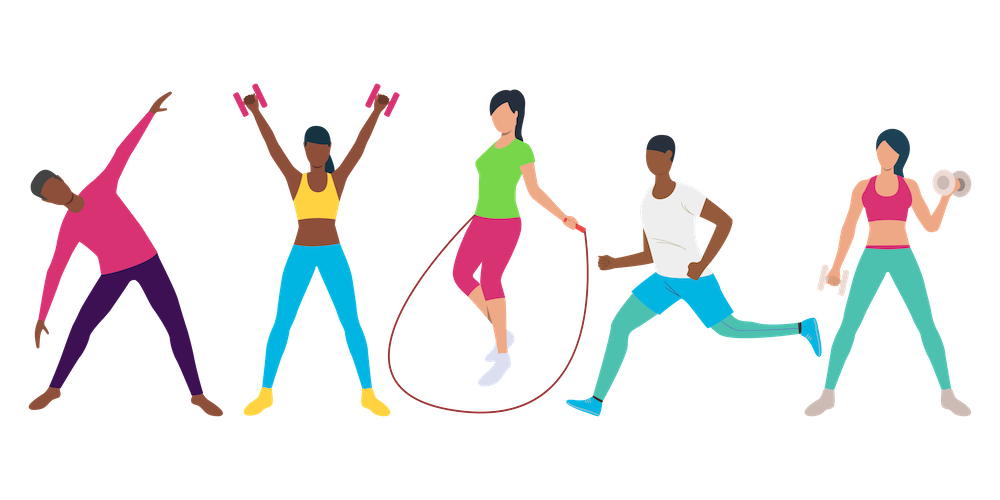
Switching up your workouts is essential for maintaining motivation, preventing plateaus, and promoting long-term fitness progress. It allows your body to adapt and challenge itself in new ways, leading to enhanced strength, endurance, and overall well-being. By incorporating variety into your fitness routine, you can avoid boredom and ensure that your workouts remain effective and enjoyable.
Designing a Sample Workout Plan
A well-designed workout plan should encompass different types of exercises to target various muscle groups and enhance overall fitness. Here’s a sample plan that incorporates cardio, strength training, and flexibility:
- Monday:Strength Training (Upper Body) – Focus on exercises like push-ups, bench press, overhead press, and rows.
- Tuesday:Cardio (Moderate Intensity) – Choose activities like jogging, swimming, cycling, or brisk walking for 30-45 minutes.
- Wednesday:Strength Training (Lower Body) – Include exercises like squats, lunges, deadlifts, and calf raises.
- Thursday:Rest or Active Recovery – Engage in low-impact activities like yoga, stretching, or light walking.
- Friday:High-Intensity Interval Training (HIIT) – Alternate between short bursts of intense exercise and brief recovery periods.
- Saturday:Flexibility and Core Strengthening – Focus on exercises like Pilates, yoga, or core-specific exercises.
- Sunday:Rest or Active Recovery – Engage in leisurely activities like hiking, gardening, or playing recreational sports.
Considerations for Transitioning Between Workout Routines
When transitioning between different workout routines, it’s crucial to consider the following factors to ensure a smooth and safe transition:
- Gradual Progression:Gradually increase the intensity, duration, and frequency of your workouts to allow your body to adapt and avoid overexertion.
- Listen to Your Body:Pay attention to any pain or discomfort and adjust your workouts accordingly. If you experience persistent pain, consult a healthcare professional.
- Proper Warm-up and Cool-down:Dedicate time to warm up your muscles before each workout and cool down afterward to prevent injuries and promote recovery.
- Cross-Training:Engage in different types of exercise to challenge different muscle groups and avoid overuse injuries.
- Rest and Recovery:Allow your body adequate time to rest and recover between workouts. Aim for 1-2 days of rest per week.
Tips for Avoiding Injuries When Switching Workouts, How often should you switch up your workouts
To minimize the risk of injuries when switching workouts, consider the following tips:
- Proper Form:Focus on maintaining proper form during exercises to avoid strain on joints and muscles.
- Progressive Overload:Gradually increase the weight, repetitions, or intensity of your workouts to challenge your muscles and prevent plateaus.
- Adequate Nutrition:Ensure you’re consuming a balanced diet that provides the necessary nutrients for muscle recovery and growth.
- Hydration:Stay adequately hydrated throughout the day, especially during and after workouts.
- Listen to Your Body:Pay attention to any pain or discomfort and adjust your workouts accordingly. If you experience persistent pain, consult a healthcare professional.
Checklist for Deciding How Often to Change Workouts
When deciding how often to switch up your workouts, consider the following factors:
- Fitness Goals:Determine your specific fitness goals and choose workouts that align with your objectives.
- Workout Routine:Evaluate your current workout routine and identify areas that need improvement or variation.
- Progress:Track your progress and assess whether your current workouts are still challenging and effective.
- Motivation:Consider your motivation levels and whether you’re enjoying your current workout routine.
- Time Constraints:Factor in your available time and choose workouts that fit your schedule.
- Injury Risk:Assess your risk of injury and choose workouts that are appropriate for your fitness level and physical condition.
Examples of Workout Variety
It’s important to keep your workouts varied to challenge your body in new ways and prevent plateaus. This can be achieved by incorporating different types of exercises, targeting various muscle groups, and adjusting the intensity and duration of your workouts.
Strength Training
Strength training is crucial for building muscle mass, improving bone density, and enhancing metabolism. It involves using resistance to challenge your muscles, leading to hypertrophy (muscle growth). Here are some examples of strength training workouts:
- Bodyweight Training:This involves using your own body weight as resistance, making it accessible and convenient. Examples include push-ups, squats, lunges, and planks. Bodyweight training can be scaled to different fitness levels by adjusting the difficulty of exercises.
- Weightlifting:This involves using external weights, such as dumbbells, barbells, or weight machines. It allows for progressive overload, where you gradually increase the weight lifted to stimulate further muscle growth. Examples include bench press, deadlifts, squats, and rows.
- Circuit Training:This involves performing a series of exercises in a circuit, with minimal rest between exercises. It’s a great way to combine strength training with cardio and can be tailored to target specific muscle groups. Examples include a circuit of squats, push-ups, lunges, and rows.
Just like you shouldn’t stick to the same workout routine forever, it’s also important to shift your self-talk around food. Instead of focusing on restriction and deprivation, try adopting a more positive and supportive approach, like exploring the positive ways to shift your self talk around food.
A fresh perspective can make a big difference in your overall health and well-being, just like switching up your workouts keeps things exciting and prevents plateaus.
Cardiovascular Exercise
Cardiovascular exercise, also known as cardio, is essential for improving heart health, increasing endurance, and burning calories. It involves activities that elevate your heart rate and increase your breathing. Here are some examples of cardio workouts:
- Running:This is a high-impact activity that provides a full-body workout. It can be done outdoors or on a treadmill and can be adjusted to different intensity levels.
- Cycling:This is a low-impact activity that can be done indoors or outdoors. It’s a great way to improve cardiovascular health and endurance while minimizing stress on joints.
- Swimming:This is a full-body workout that is low-impact and excellent for people with joint pain. It provides a good cardiovascular workout and is a great way to improve flexibility.
- Dancing:This is a fun and engaging way to get a cardio workout. It involves various movements that challenge different muscle groups and improve coordination.
Flexibility and Mobility
Flexibility and mobility exercises are crucial for maintaining a healthy range of motion, preventing injuries, and improving posture. They involve stretching and moving your joints through their full range of motion. Here are some examples of flexibility and mobility workouts:
- Yoga:This ancient practice involves a series of poses that improve flexibility, strength, and balance. It also promotes mindfulness and relaxation.
- Pilates:This exercise method focuses on core strength, flexibility, and posture. It uses controlled movements and resistance to improve muscle control and coordination.
- Dynamic Stretching:This involves performing controlled movements that take your joints through their full range of motion. It’s a great way to warm up before a workout and improve flexibility.
- Static Stretching:This involves holding a stretch for a period of time, typically 30 seconds or more. It’s a great way to improve flexibility and increase range of motion.
Workout Examples by Muscle Group
Here is a table outlining various workout examples categorized by muscle groups targeted:
| Muscle Group | Workout Example | Exercises |
|---|---|---|
| Upper Body | Push-ups | Push-ups, bench press, overhead press, dumbbell rows, pull-ups |
| Lower Body | Squats | Squats, lunges, deadlifts, leg press, calf raises |
| Core | Plank | Plank, crunches, Russian twists, leg raises, bicycle crunches |
| Full Body | Circuit Training | Squats, push-ups, lunges, rows, planks, burpees, jumping jacks |
Importance of Rest and Recovery: How Often Should You Switch Up Your Workouts

Rest and recovery are crucial components of any fitness program. Just as important as the workouts themselves, rest allows your body to rebuild and repair muscle tissue, replenish energy stores, and prevent injuries. It’s not about being inactive; it’s about giving your body the time it needs to recover and adapt to the demands of your training.
Role of Rest Days in Preventing Injuries and Muscle Soreness
Rest days play a vital role in injury prevention and muscle soreness management. When you exercise, your muscles experience microscopic tears. These tears are the foundation for muscle growth, but they also cause inflammation and soreness. Rest allows your body to repair these tears, reducing the risk of further damage and promoting muscle recovery.
“Rest days are not lazy days. They are essential for your body to rebuild and repair muscle tissue, replenish energy stores, and prevent injuries.”
Strategies for Incorporating Rest and Recovery into a Workout Plan
Incorporating rest into your workout plan is essential for maximizing your fitness gains and minimizing the risk of injury. Here are some effective strategies:
- Schedule Rest Days:Plan for at least one or two rest days per week, depending on your training intensity and fitness level. These days allow your body to recover from the physical stress of exercise.
- Active Recovery:Engage in low-intensity activities like walking, swimming, or yoga on your rest days. These activities promote blood flow and flexibility without putting excessive strain on your muscles.
- Listen to Your Body:Pay attention to your body’s signals. If you feel fatigued, sore, or experiencing pain, take a rest day or reduce your workout intensity.
Tips for Maximizing Rest and Recovery Time
Maximizing your rest and recovery time can significantly enhance your fitness progress and overall well-being. Here are some tips:
- Prioritize Sleep:Aim for 7-9 hours of quality sleep each night. Sleep is essential for muscle repair, hormone regulation, and cognitive function.
- Hydrate:Drink plenty of water throughout the day, especially after workouts. Dehydration can hinder recovery and increase muscle soreness.
- Nutrition:Consume a balanced diet rich in protein, carbohydrates, and healthy fats to support muscle recovery and energy replenishment.
- Stress Management:Chronic stress can negatively impact recovery. Practice relaxation techniques like meditation, deep breathing, or yoga to manage stress levels.
End of Discussion
Ultimately, the frequency with which you switch up your workouts depends on your individual goals, fitness level, and how your body responds. Listen to your body, experiment with different routines, and don’t be afraid to adjust your approach as needed.
Remember, fitness is a journey, not a destination, and the key is to find what works best for you.

